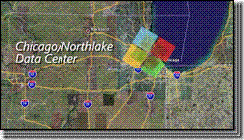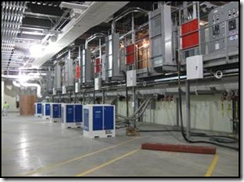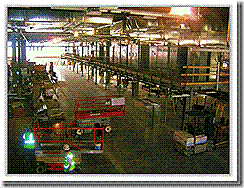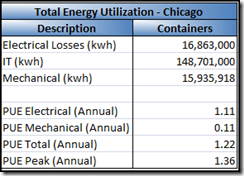First let me start out with the fact that the need for datacenter measurement is paramount if this industry is to be able to manage itself effectively. When I give a talk I usually begin by asking the crowd three basic questions
1) How many in attendance are monitoring and tracking electrical usage?
2) How many in attendance measure datacenter efficiency?
3) How many work for organizations in which the CIO looks at the power bills?
The response to these questions has been abysmally low for years, but I have been delighted by the fact that slowly but surely, the numbers have been rising. Not in great numbers mind you, but incrementing. We are approaching a critical time in the development of the data center industry and where it (and the technologies involved) will go.
To that end there is no doubt that the PUE metric has been instrumental in driving awareness and visibility on the space. The Green Grid really did a great job in pulling this metric together evangelizing it to the industry. Despite a host of other potential metrics out there, PUE has captured the industry given its relatively straight forward approach. But PUE is poised to be a victim of its own success in my opinion unless the industry takes steps to standardizes its use in marketing material and how it is talked about.
Don’t get me wrong, I am rabidly committed to PUE as a metric and as a guiding tool in our industry. In fact I have publicly defended the detractors of this metric for years. So this post is a small plea for sanity.
These days, I view each and every public statement of PUE with a full heaping shovel-full of skepticism regardless of company or perceived leadership position. In my mind measurement of your company’s environment and energy efficiency is a pretty personal experience. I don’t care which metric you use (even if its not PUE) as long as you take a base measurement and consistently measure over time making changes to achieve greater and greater efficiency. There is no magic pill, no technology, no approach that gives you efficiency nirvana. It is a process that involves technology (both high tech and low tech), process, procedure, and old fashioned roll up your sleeves operational best practices over time that gets you there.
With mounting efforts around regulation, internal scrutiny around capital spending, lack of general market inventory and a host of other reasons, the push for efficiency has never been greater and the spotlight on efficiency as a function of “data center product” is in full swing. Increasingly PUE is moving from the data center professional and facilities groups to the marketing department. I view this as bad.
Enter the Marketing Department
In my new role I get visibility to all sorts of interesting things I never got to see in my role managing the infrastructure for a globally ubiquitous cloud roll out. One of the more interesting items was an RFP issued by a local regional government for a data center requirement. The RFP had all the normal things you would expect to find in terms of looking for that kind of thing, but there was a caveat that this facility must have a PUE of 1.2. When questioned around this PUE target, the person in charge stated, if Google and Microsoft are achieving this level we want the same thing and this is becoming the industry standard. Of course the realization in differences in application make up, legacy systems, or the fact that it would have to also house massive tape libraries (read low power density) and a host of other factors made it impossible for them to really achieve this. It was then that I started to get an inkling that PUE was starting to get away from its original intention.
You don’t have to look far to read about the latest company that has broken the new PUE barrier of 1.5 or 1.4 or 1.3 or 1.2 or even 1.1. Its like the space race. Except that the claims of achieving those milestones are never really backed up with real data to prove or disprove it. Its all a bunch of nonsensical bunk. And its in this nonsensical bunk that we will damn ourselves with those who have absolutely no clue about how this stuff actually works. Marketing wants the quick bullet points and a vehicle to allow them to show some kind of technological superiority or green badges of honor. When someone walks up to me at a tradeshow or emails me braggadocios claims of PUE they are unconsciously picking a fight with me and I am always up for the task.
WHICH PUE DO YOU USE?
Lets have an honest, open and frank conversation around this topic shall we? When someone tells me of the latest greatest PUE they have achieved, or have heard about, my first question is ‘Oh yeah? Which PUE are they/you using?’. I love the response I typically get when I ask the question. Eyebrows twist up and a perplexed look takes over their face. Which PUE?
If you think about it, its a valid question. Are they looking at Average Annual PUE? Are they looking at AVERAGE PEAK PUE? Are they looking at design point PUE? Are they looking at Annual Average Calculated PUE? Are they looking at Commissioning state PUE? What is the interval at which they are measuring? Is this the PUE rating they achieved one time at 1:30AM on the coldest night in January?
I sound like an engineer here but there is a vast territory of values between these numbers all of them and none of them may have anything to do with reality. If you will allow me a bit of role-playing here lets walk through a scenario where we (you and I dear reader) are about to build and commission our first facility.
We are building out a 1MW facility with a targeted PUE of 1.5. After successful build out with no problems or hiccups (we are role-playing remember) we begin the commissioning with load banks to simulate load. During the process of commissioning we have a measured PUE our target of 1.40. Congratulations we have beaten our design goal! right? We have crossed the 1.5 barrier! Well maybe not. Lets ask the question…How long did we run the Level 5 commissioning for? There are some vendors who burn it in over a course of 12 hours. Some a full day. Does that 1.40 represent the average of the values collected? Does it measure the averaged peak? Was it the lowest value? What month are we in? Will it be significantly different in July? January? May? Where is the facility located? The scores over time versus at commissioning will vary significantly over time.
A few years back when I was at Microsoft, we publicly released the data below for a mature facility at capacity that has been operating and collecting information four years. We had been tracking PUE or at least the variables used in PUE for that long. You can see in the chart the variations of PUE. Keep in mind this chart shows a very concentrated effort to drive efficiency over time. Even in a mature facility where the load remains mostly constant over time, the PUE has variation and fluctuation. Add to that the deltas between average, peak and average peak. Which numbers are you using?

(source: GreenM3 blog)
Ok lets say we settle on using just average (its always the lowest number PUE with the exception of a one time measurement). We want to look good to management right? If you are a colo company or data center wholesaler you may even give marketing a look-see to see if there is any value in that regard. We are very proud of ourselves. There is much back slapping and glad handing as we send our production model out the door.
Just like an automobile our data center depreciates quickly as soon as the wheels hit the street. Except that with data centers its the PUE that is negatively affected.
The IMPORTANCE OF USE
Our brand new facility is now empty. The load-banks have been removed, we have pristine white floor space ready to go. With little to no IT load in our facility we currently have a PUE somewhere between 7 and 500. Its just math (refer back to how PUE is actually calculated). So now our PUE will be a function of how quickly we consume the capacity. But wait, how can our PUE be so high? We have proof from commissioning that we have created an extremely efficient facility. Its all in the math. Its math marketing people don’t like. It screws with the message. Small revelation here – Data Centers become more “efficient” the more energy they consume! Regulations that take PUE into account will need to worry about this troublesome side effect.
There are lots of interesting things you can do to minimize this extremely high PUE at launch like shutting down CRAH units, removing perf tiles and replacing them with solid tiles, but ultimately your PUE is going to be much much higher regardless.
Now lets take the actual deployment of IT ramps in new data centers. In many cases enterprises build data centers to last them over a long period of time. This means that there is little likelihood that your facility will look close to your commissioning numbers (with load banks installed). Add to the fact that traditional data center construction has you building out all of the capacity from the start. This essentially means that your PUE is not going to have a great story for quite a bit of time. Its also why I am high on the modularized approach. Smaller, more modular units allow you to more efficiently (from cost as well as energy efficiency) grow your facility out.
So if we go back to our marketing friends, our PUE looks nothing like the announcement any more. Future external audits might highlight this, and we may full under scrutiny of falsely advertising our numbers. So lets pretend we are trying to do everything correctly and have projected that we will completely fill our facility in 5 years.
The first year we successfully fill 200kw of load in our facility. We are right on track. Except that the 200kw was likely not deployed all at once. It was deployed over the course of the year. Which means my end of year PUE number may be something like 3.5 but it was much higher earlier in the year. If I take my annual average, it certainly wont be 3.5. It will be much higher. In fact if I equally distribute the 200kw that first year over 12 months, my PUE looks like this:

That looks nothing like the PUE we advertised does it? Additionally I am not even counting the variability introduced by time. This is just end of month numbers. So the frequency will have an impact on this number as well. The second year of operation our numbers are still quite poor when compared to our initial numbers.

Again, if I take annual average PUE for the second year of operation, I am not at my design target nor am I at our commissioned PUE rating. So how can firms unequivocally state such wonder PUEs? They cant. Even this extremely simplistic example doesn’t take into effect that load in the data center moves around based upon utilization, it also almost never achieves the power draw you think it will take. There are lots of variables here.
Lets be clear – This is how PUE is supposed to work! There is nothing wrong with these calcs. There is nothing wrong with the high values. It is what it is. The goal is to drive efficiency in your usage. Falsely focusing on extremely low numbers that are the result of highly optimized integration between software and infrastructure and making them the desirable targets will do nothing more than place barriers and obstacles in our way later on. Outsiders looking in want to find simplicity. They want to find the quick and dirty numbers by which to manage the industry by. As engineers you know this is a bit more complex. Marketing efforts and focusing on low PUEs will only damn us later on.
Additionally, if you allow me to put my manager/businessman hat on – there is a law of diminishing return by focusing on lower and lower PUE. The cost for continued integration and optimization starts losing its overall business value and gains in efficiency are offset by the costs to achieve those gains. I speak as someone who drove numbers down into that range. The larger industry would be better served by focusing more on application architecture, machine utilization, virtualization, and like technologies before pushing closer to 1.0.
So what to do?
I fundamentally believe that this would be an easy thing to correct. But its completely dependent upon how strong a role the Green Grid wants to play in this. I feel that the Green Grid has the authority and responsibility to establish guidelines in the formal usage of PUE ratings. I would posit the following ratings with apologies in advance as I am not a marketing guy who could come up with more clever names:
Design Target PUE (DTP) – This is the PUE rating that theoretically the design should be able to achieve. I see too many designs that have never manifested physically. This would be the least “trustworthy” rating until the facility or approach has been built.
Commissioned Witnessed PUE (CWP) – This is the actual PUE witnessed at the time of commissioning of the facility. There is a certainty about this rating as it has actually achieved and witnessed. This would be the rating that most colo providers and wholesalers would need to use as they have little impact or visibility into customer usage.
Annual Average PUE (AAP) – This is what it says it is. However I think that the Green Grid needs to come up with a minimal standard of frequency (my recommendation is at least 3 times a day, data collection) to establish this rating. You also couldn’t publish this number without a full years worth of data.
Annual Average Peak PUE (APP) – My preference would be to use this as its a value that actually matters to the ongoing operation of the facility. When you combine with the Operations challenge of managing power within a facility, you need to account for peaks more carefully especially as you approach the end capacity of the space you are deploying. Again hard frequencies need to be established along with a full years worth of data here as well.
I think this would greatly cut back on ridiculous claims or at least get closer to a “truth in advertising’ position. It would also allow for outside agencies to come in and audit those claims over time. You could easily see extensions to the ISO14k and ISO27K and other audit certifications to test for it. Additionally it gives the outsiders a peak at the complexity at the space and allows for smarter mechanics that drive for greater efficiency (how about a 10% APP reduction target per year instead).
As the Green Grid is a consortium of different companies (some of whom are likely to want to keep the fuzziness around PUE for their own gains) it will be interesting to see if they step into better controlling the monster we have unleashed.
Lets re-claim PUE and Metrics from the Marketing People.
\Mm











